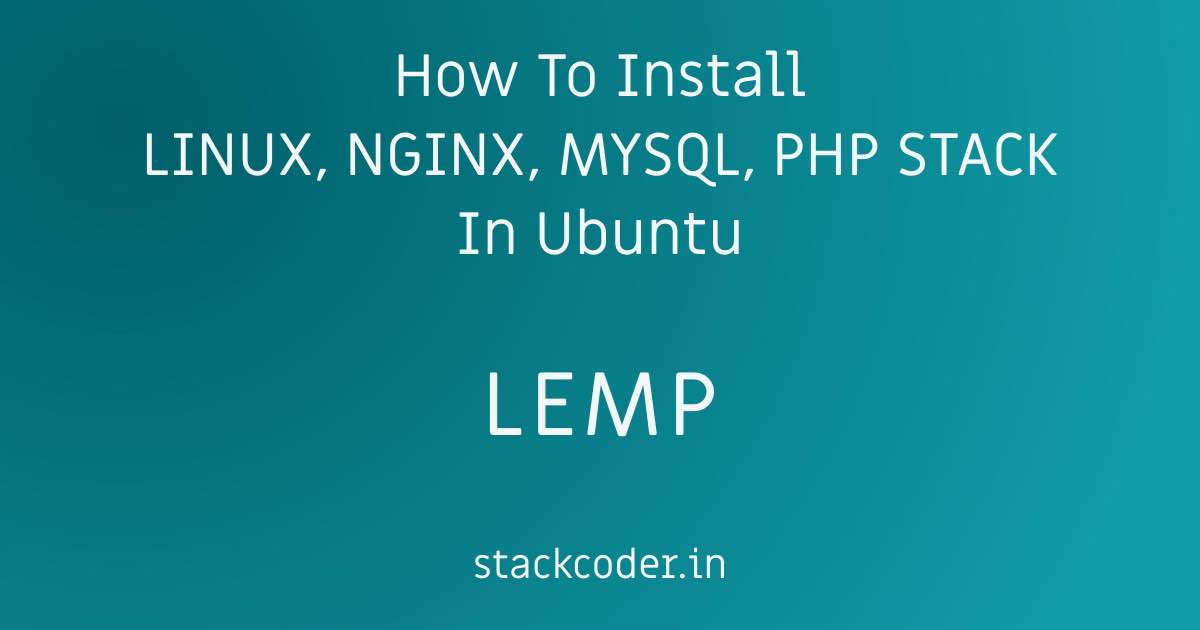
Good content takes time and effort to come up with.
Please consider supporting us by just disabling your AD BLOCKER and reloading this page again.

Install Linux, NGINX, MYSQL, PHP (LEMP Stack) on Ubuntu
Hello friends in this post I am gonna show you how to setup LEMP in Ubuntu server.
LEMP stands for L - LINUX, E - NGINX, M - MYSQL, P - PHP (Basically PHP-FPM for NGINX server)
Prerequisites
Before moving ahead with this article I request you guys to setup up Ubuntu server in Digital Ocean, Linode, or any other cloud platform. If you don't have an account then click on the link and get the free credits to play around :)
If you're still using password logins or root SSH logins. Then I highly recommend you to check on How To Do Basic Server Security Setup For Ubuntu / Linux
Login to your server and follow along with the following steps.
Step 1 - Install NGINX webserver
NGINX is similar to you that of Apache webserver which handles all your server incoming requests on port 80
sudo apt-get update
sudo apt-get install nginx
To cross verify whether the installation is successful or not you can simply open your server ip_address in your browser as follows
http://your_server_ip_address
You will see a NGINX successfully installed page. Which loads from /var/www/html/ folder
Step 2 - Install the MYSQL database & secure it with a password
MYSQL is a relational database that is used to store the dynamic data and fetch the data which will come from login, register, and various other types of forms
sudo apt-get install mysql-server
Now the MYSQL database is installed. As earlier now MYSQL won't prompt for a password. So to securely install the MYSQL server use the following commands
sudo mysql_secure_installation
You might be prompted to VALIDATE PASSWORD PLUGIN please select NO. Else, it will create a lot of fuss for the passwords at a later point.
By chance, if you select YES the option then you will get the following prompt
There are three levels of a password validation policy. Select difficulty based on your requirement.
LOW Length >= 8
MEDIUM Length >= 8, numeric, mixed case, and special characters
STRONG Length >= 8, numeric, mixed case, special characters and dictionary file
Please enter 0 = LOW, 1 = MEDIUM and 2 = STRONG:
Next, add the root user password and confirm the password.
New password:
Re-enter new password:
For best security practices it's a good idea to press YES for the subsequent prompts. These prompts include remove anonymous users, remove the test databases, disable remote root logins and flush privileges to save changes into effect.
By default, you will be root a user with auth_socket enabled connection. This means while connecting to the database no need for any passwords. At some point later this might cause security issues. So it's better to add the password authentication for all requesting connections.
Let me show you the same. First, let's login to MYSQL
sudo mysql
Next, run the following to see the details of the root user
SELECT user,authentication_string,plugin,host FROM mysql.user;
Once you run the above command you can see that root user doesn't have the authentication_string ie password.
Output
+------------------+-------------------------------------------+-----------------------+-----------+
| user | authentication_string | plugin | host |
+------------------+-------------------------------------------+-----------------------+-----------+
| root | | auth_socket | localhost |
To set the password run the following command, make sure to change the your_password with the valid required password
ALTER USER 'root'@'localhost' IDENTIFIED WITH mysql_native_password BY 'your_password';
Run the following command so that the changes make will take an effect.
FLUSH PRIVILEGES;
Now again if you re-run the above command to check if the password is set or not then it will set with mysql_native_password. No worries if your not able to see them authentication_string as it will be encrypted by MYSQL
Output
+------------------+-------------------------------------------+-----------------------+-----------+
| user | authentication_string | plugin | host |
+------------------+-------------------------------------------+-----------------------+-----------+
| root | *549966GJ45794839F92C1571D6D78F | mysql_native_password | localhost |
Now you can safely exit from MYSQL prompt. If you try to log in as sudo mysql then it won't allow. You need to add your_password to do so.
Step 3 – Install PHP and its packages
You are doing a great job. Now you have installed NGINX webserver and MYSQL its time to set up your PHP so that your PHP scripts run.
NGINX unlike APACHE doesn't have any native code to instruct that PHP scripts need to be processed. Now, NGINX has to pass the PHP processing requests to PHP-FPM (FAST CGI PROCESS MANAGER)
Now install all the PHP packages in the Ubuntu server with the following command. No need to add a specific version like the way I will do in the following command. But make sure that your local development and now installing PHP version matches else if you use composer in the future you will have to face some problems.
sudo apt install php7.4-fpm php7.4-mysql php7.4-curl php7.4-zip php7.4-json
If your installing LARAVEL then better to run the following command to install all packages at once
sudo apt-get install php7.4-fpm php7.4-cli php7.4-common php7.4-curl php7.4-gd php7.4-gmp php7.4-json php7.4-mbstring php7.4-mysql php7.4-xml php7.4-zip composer git zip unzip
You can add composer, zip, unzip, git in the same command instead of adding later :)
Step 4 - Configure PHP with NGINX webserver
Once the PHP , MYSQL & NGINX installation is done then your left with configuring NGINX with PHP-FPM. As we had discussed earlier that NGINX by itself cannot process the PHP scripts you need to do this process.
First, you need to set up NGINX for your site. Basically, you will find all NGINX available configurations in the following path
/etc/nginx/sites-available/
To check if any of these configurations are enabled or not then you need to check in the following path.
NOTE: These are only symbolic links which will be pointing to your /etc/nginx/sites-available directory
/etc/nginx/sites-enabled/
Make sure to replace your_website_name.com with your domain name in the following configuration.
sudo nano /etc/nginx/sites-available/your_domain_name.com
Now add the following configuration to the file. In the following, if you don't have a domain name still then just add the ip_address of your domain name.
server {
listen 80;
root /var/www/html;
index index.php index.html;
#Make sure to change your domain name in the following line too.
server_name your_domain_name.com www.your_domain_name.com;
location / {
try_files $uri $uri/ =404;
}
location ~ \.php$ {
include snippets/fastcgi-php.conf;
fastcgi_pass unix:/var/run/php/php7.4-fpm.sock;
}
location ~ /\.ht {
deny all;
}
}
Now you have added your_domain_name.com NGINX configuration lets activate it by the following command
sudo ln -s /etc/nginx/sites-available/your_domain_name.com /etc/nginx/sites-enabled/
Activating your domain name is nothing but adding the symbolic link in your /etc/nginx/sites-enabled/ folder. Which will be read by the NGINX main configuration file nginx.conf which resides in /etc/nginx/nginx.conf
As a default, NGINX will have default configuration which will be activated we have to unlink from /etc/nginx/sites-enabled/default with the following command
sudo unlink /etc/nginx/sites-enabled/default
NOTE: Remember here we just unlinking the file. Still, your main file exists in /etc/nginx/sites-available the folder which you can activate at any given point of time with the following command
sudo ln -s /etc/nginx/sites-available/default /etc/nginx/sites-enabled/
Step 5- Test & restart your NGINX configuration
This is a very important step. Don't forget to restart you NGINX server. Else the configuration that you have added won't work.
First, check if the NGINX added code to the configuration file is proper or not by the following command
sudo nginx -t
You must be able to see similar output
nginx: the configuration file /etc/nginx/nginx.conf syntax is ok
nginx: configuration file /etc/nginx/nginx.conf test is successful
Now reload the NGINX server configuration file with the following
sudo service nginx reload
Step 6 - Finally check if the configuration is working
Now you have install LEMP and it's time to check if it paid your efforts. First, create testing.php file inside /var/www/html/ like /var/www/html/testing.php
sudo nano /var/www/hml/testing.php
And add the following code
<?php
echo 'LEMP installtion completed.';
Now browse URL http://website_name.com/testing.php or http://ip_address/testing.php from browser and you must be able to see the following output
LEMP installation completed.
Congrats on setting up your LEMP stack.
Conclusion
Now you know how to install the LEMP stack. Hope this article helped you. I have written other articles on NGINX kindly check them too
Articles For You
Install NGINX In Linux / Ubuntu And Managing
Global Data In All Laravel Blade Pages
What Is Composer? How Does It Work? Useful Composer Commands And Usage
Free SSL Certificate In cPanel With ZeroSSL & Certbot
composer.json v/s composer.lock
Search Engine Optimization Concepts
Install RabbitMQ with Docker & Running with NodeJS
Laravel 7.x Multiple Database Connections, Migrations, Relationships & Querying
Free Live Chat Integration Using TAWK.IO
SQLite Doesn't Support Dropping Foreign Keys in Laravel
Laravel Last Executed Query In Plain SQL Statement For Debugging







